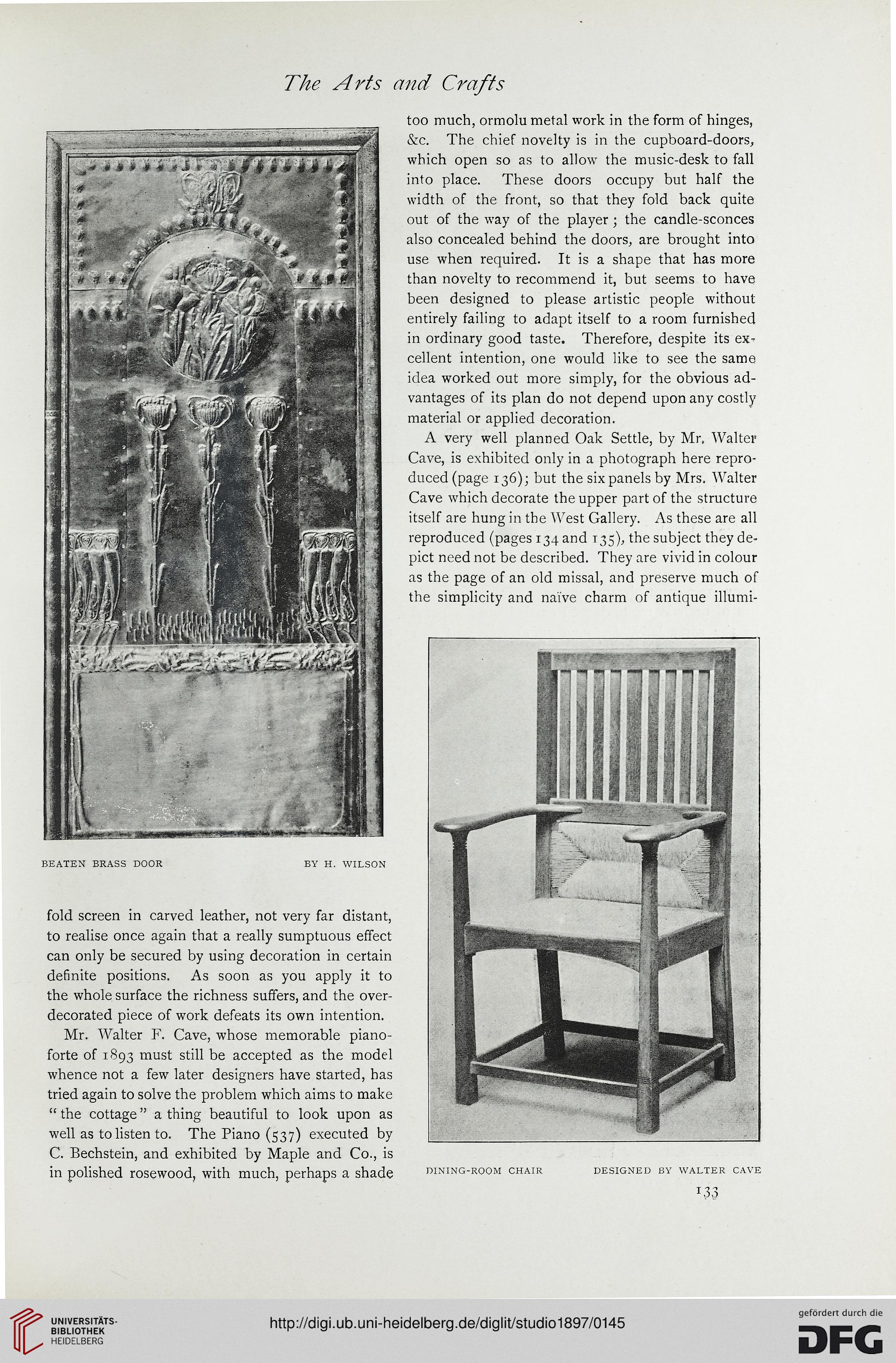The Arts and Crafts
BEATEN BRASS DOOR BY H. WILSON
fold screen in carved leather, not very far distant,
to realise once again that a really sumptuous effect
can only be secured by using decoration in certain
definite positions. As soon as you apply it to
the whole surface the richness suffers, and the over-
decorated piece of work defeats its own intention.
Mr. Walter F. Cave, whose memorable piano-
forte of 1893 must still be accepted as the model
whence not a few later designers have started, has
tried again to solve the problem which aims to make
" the cottage" a thing beautiful to look upon as
well as to listen to. The Piano (537) executed by
C. Bechstein, and exhibited by Maple and Co., is
in polished rosewood, with much, perhaps a shade
too much, ormolu metal work in the form of hinges,
&c. The chief novelty is in the cupboard-doors,
which open so as to allow the music-desk to fall
into place. These doors occupy but half the
width of the front, so that they fold back quite
out of the way of the player ; the candle-sconces
also concealed behind the doors, are brought into
use when required. It is a shape that has more
than novelty to recommend it, but seems to have
been designed to please artistic people without
entirely failing to adapt itself to a room furnished
in ordinary good taste. Therefore, despite its ex-
cellent intention, one would like to see the same
idea worked out more simply, for the obvious ad-
vantages of its plan do not depend upon any costly
material or applied decoration.
A very well planned Oak Settle, by Mr, Walter
Cave, is exhibited only in a photograph here repro-
duced (page 136); but the six panels by Mrs. Walter
Cave which decorate the upper part of the structure
itself are hung in the West Gallery. As these are all
reproduced (pages 134 and 135), the subject they de-
pict need not be described. They are vivid in colour
as the page of an old missal, and preserve much of
the simplicity and naive charm of antique illumi-
DINING-ROOM CHAIR DESIGNED BY WALTER CAVE
I33
BEATEN BRASS DOOR BY H. WILSON
fold screen in carved leather, not very far distant,
to realise once again that a really sumptuous effect
can only be secured by using decoration in certain
definite positions. As soon as you apply it to
the whole surface the richness suffers, and the over-
decorated piece of work defeats its own intention.
Mr. Walter F. Cave, whose memorable piano-
forte of 1893 must still be accepted as the model
whence not a few later designers have started, has
tried again to solve the problem which aims to make
" the cottage" a thing beautiful to look upon as
well as to listen to. The Piano (537) executed by
C. Bechstein, and exhibited by Maple and Co., is
in polished rosewood, with much, perhaps a shade
too much, ormolu metal work in the form of hinges,
&c. The chief novelty is in the cupboard-doors,
which open so as to allow the music-desk to fall
into place. These doors occupy but half the
width of the front, so that they fold back quite
out of the way of the player ; the candle-sconces
also concealed behind the doors, are brought into
use when required. It is a shape that has more
than novelty to recommend it, but seems to have
been designed to please artistic people without
entirely failing to adapt itself to a room furnished
in ordinary good taste. Therefore, despite its ex-
cellent intention, one would like to see the same
idea worked out more simply, for the obvious ad-
vantages of its plan do not depend upon any costly
material or applied decoration.
A very well planned Oak Settle, by Mr, Walter
Cave, is exhibited only in a photograph here repro-
duced (page 136); but the six panels by Mrs. Walter
Cave which decorate the upper part of the structure
itself are hung in the West Gallery. As these are all
reproduced (pages 134 and 135), the subject they de-
pict need not be described. They are vivid in colour
as the page of an old missal, and preserve much of
the simplicity and naive charm of antique illumi-
DINING-ROOM CHAIR DESIGNED BY WALTER CAVE
I33




